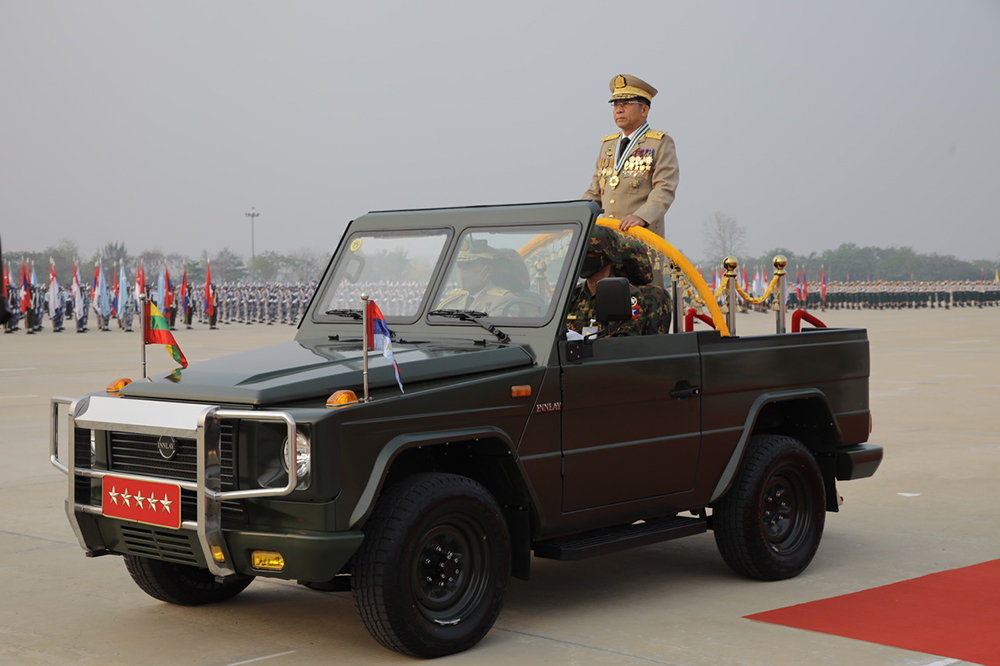Myanmar’s military regime marked its Armed Forces Day on Saturday by slaughtering more than 100 people across the country, making it the bloodiest single day since the generals seized power on Feb. 1.
As of evening, The Irrawaddy has recorded at least 102 people, including at least four children ranging in age from 5 to 15, killed on Saturday in 41 locations in 10 out of Myanmar’s 14 states and regions.
Most of the victims were shot dead by trigger-happy soldiers and police during crackdowns on anti-protesters. One child was hit with a randomly sprayed bullet while playing.
Since early February, the junta has staged fatal assaults on protesters across the country who are opposed to military rule. A total of 429 have been slain so far.
While Saturday marked the seventh week of protest against the regime, it was also the 76th anniversary of Armed Forces Day, an annual celebration for the military to mark Myanmar’s resistance against the Japanese fascists in 1945.
However, protesters across the country viewed Saturday as “Revolutionary Day” against the regime and poured into streets. True to form, the regime’s soldiers and police responded with a burst of bloodshed, as if the heightened violence was a way of commemorating their special occasion.
The bloodshed came to Dala Township, a small town across the Yangon River, just after midnight. Eight people were shot dead about 12:30 a.m. Saturday as a crowd besieged a police station demanding that security forces release two women detained after a protest on Friday morning.
“They [security forces] kept shooting until 3 a.m. Several people were injured. Some of them are still critical condition,” a witness said.

In northern Yangon’s Insein Township, residents took to the streets at 2:30 a.m. to set up roadblocks, taking advantage of the absence of security forces in the small hours. Deadly crackdowns came about 6 a.m. and continued on into the day, resulting in four deaths.
A nurse from a local professional medic team that provided medical assistance in the area throughout the day said that not only protesters were slain. People like a drinking water deliveryman and other bystanders were either shot dead in the head and abdomen or wounded as attacks continued in neighboring areas and townships.
“They are devils. How can a human being behave like this? I can’t even find any proper words to describe their brutality,” said the nurse who gave her name as “Soe” for security reasons.
While Insein residents ran for their lives and fought back with whatever they could find—from broken bricks to slingshots to Molotov cocktails to burning piles of tires—coup leader Senior General Min Aung Hlaing celebrated Armed Forces Day on a grand scale in the capital 200 miles away.
In his lengthy and cliché-ridden speech to a gathering of troops, he said the military has historically prioritized the safeguarding of the nation and its people and repeated his worn out excuse on staging the takeover by saying, “There was massive electoral fraud.”
A few hours after of his boast about how the military safeguards the nation and its people, his troops killed four civilians, including a 13-year-old girl, in Meiktila in Mandalay Region. The deaths occurred when security forces fired shots into a housing estate in an effort to disperse protesters.
It’s worth asking why the people of Myanmar are still taking to the streets, risking their lives to the violence of the regime’s troops.
A 26-year-old protester in Yangon’s Thaketa Township said he keeps protesting because he’s afraid of losing his future in the regime’s hands.
“We are not lambs to the slaughter. But if we stayed quiet, it would be the same as dying. So we fight for our hope and our future,” he said.
In northern Shan State’s Lashio, three more protesters including a lawyer were killed. They were shot in the head and chest when police and soldiers opened fire on anti-coup demonstrators, according to a local charity group. It also reported that several people were wounded during the crackdown.
“We could not retrieve the dead bodies. They dragged the bodies and the injured people onto a military truck,” a volunteer from the charity group told The Irrawaddy.

Not surprisingly, the record-breaking killings by soldiers and police on Armed Forces Day have shocked diplomatic missions in the country.
The European Union in Myanmar said, “This 76th Myanmar Armed Forces Day will forever stay engraved as a day of terror and dishonor.”
“The killing of unarmed civilians, including children, is indefensible,” the EU statement said.
US Ambassador Thomas Vajda condemned the security forces for “murdering unarmed civilians, including children, the very people they swore to protect” while calling for an immediate end to the violence and the restoration of the democratically elected government.
“This bloodshed is horrifying. These are not the actions of a professional military or police force,” he said in a statement released on Saturday.
For the nurse Soe in Yangon, the regime’s brutality prompted her to question one of her professional ethics: neutrality.
“As professional health workers, we are supposed to help anyone whoever they are. But they even killed kids! They shot people living in their homes,” she said.
So, would she save a dying soldier or wounded policeman now?
“I would surely do it in the past. But, not now!” she vowed.
You may also like these stories:
Myanmar Regime Unwittingly Acknowledges ‘Shoot-to-Kill’ Policy Against Protesters
Myanmar Regime Kills 23 More Protesters as It Marks Armed Forces Day
Protest Fatalities at Hands of Myanmar Military Regime Now Stand at 327

















